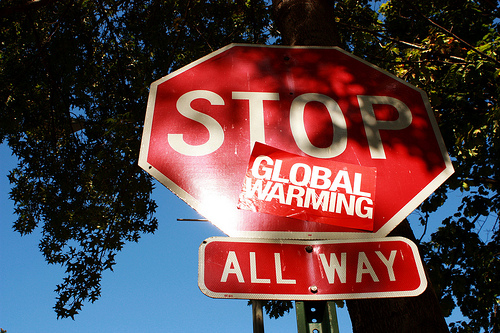 He’s ready for a new plan.Photo: The White HouseCongress’ failure to act on global climate change was one of the reasons the diplomatic atmosphere was so chilly last year in Copenhagen.
He’s ready for a new plan.Photo: The White HouseCongress’ failure to act on global climate change was one of the reasons the diplomatic atmosphere was so chilly last year in Copenhagen.
Congress has chilled the atmosphere again, four months before the international community meets in Cancun to resume its marathon crawl to a global climate treaty. From Bonn, where nations were attending five days of pre-Cancun negotiations this week, the Associated Press reported the Senate’s failure to act on a climate bill has “deepened the distrust among poor countries about the intentions of the United States and other industrial countries” to cut their emissions.
The response from members of the Obama team has been: a) the president is not backing off his commitment to legislation or a 17 percent reduction in greenhouse gas emissions; and b) there is more than one way to skin this cat. Hints of executive action are in the wind.
Also in the wind is a renewed discussion about the role states can play in cutting our carbon emissions. For example, the World Resources Institute concludes [PDF] that if states are “go-getters” with the policies they already have in place, they can make a significant contribution to the president’s 17 percent goal.
Now comes an even fresher report — this one from the Presidential Climate Action Project (PCAP) — that details several ways President Obama also can be a “go-getter,” using powers Congress delegated to the Executive Branch in the past.
PCAP offers five ideas for presidential action, with details on how to implement them before Cancun:
1. In full partnership with state, tribal, and local government leaders, create a national roadmap to the clean energy economy: Great Britain has a detailed roadmap with specific milestones for achieving a low-carbon economy by 2020. The United States does not.
Rather than preempting the power of states to deal with climate change, as some climate bills in the Senate would do, the national roadmap should show how the federal government can help states be even better go-getters. Cities, too.
According to the Center for Climate Strategies, if all 50 states adopted a set of 23 energy and climate policies (policies the Center identified in working with more than 1,500 stakeholders), they could cut emissions 27 percent by 2020 compared to 1990 levels, about nine times deeper than the cuts the president has proposed. At the same time, those 23 policies would boost GDP by $134 billion, save consumers $5 billion, and create 2.5 million new jobs. That’s the ideal case, of course, but it illustrates the potential.
Another recent report, from IHS Emerging Energy Research, calculates renewable energy generation in the U.S. will grow 250 percent in the next 15 years if the states that already have renewable energy portfolio standards fully implement them.
2. Declare a war on waste: The American Council for an Energy Efficient Economy (ACEEE) calculates that the U.S. economy wastes 87 percent of the energy it consumes. During his campaign, Obama cited a United Nation’s report that placed the United States 22nd in energy efficiency among the major economies. The Obama/Biden energy platform promised “an Obama Administration will strive to make America the most energy efficient country in the world.”
It’s time to make that goal official. Obama should challenge the United States — with the help of every citizen and sector — to become the world’s most energy-efficient industrial economy by 2035. According to economist Skip Laitner at the ACEEE, that goal can be achieved if the nation begins improving its efficiency 3.1 percent annually.
3. Reinvent national transportation policy: This is a goal mostly for Congress as it considers the surface transportation reauthorization bill next year. But Obama can give traction to real reform if he gets behind it.
Today, states are awarded more federal funding for building roads than for building mass-transit systems. The incentives should be reversed. Reducing America’s “vehicle miles traveled” should be at the top of federal transportation policy, alongside better vehicle fuel efficiency. Meantime, President Obama can fulfill another campaign promise by starting work on a national low-carbon fuel standard.
4. Stop subsidizing fossil fuels: The oil, coal, and gas industries in the United States are like 50-year-old children still on the breast. They are mature and ridiculously wealthy; they shouldn’t need taxpayers to subsidize them.
In his 2011 budget, Obama proposed cutting fossil energy subsidies by $30 billion over 10 years, but that only scratches the surface of public subsidies for these industries. Likewise, Obama championed and won approval by the G-20 to phase out about $310 billion annually in fossil energy subsidies in other countries. New estimates from the International Energy Agency indicate, however, that subsidies of fossil energy consumption (not counting subsidies for production) were around $560 billion in 2008. Phasing out these subsidies over the next decade would achieve more than 30 percent of the cuts in carbon emissions necessary to keep rising atmospheric temperatures at no more than 2 degrees C above pre-industrial levels, the IEA says [PDF].
President Obama’s goals on fossil energy subsidies could be more aggressive. Meantime, he should phase out taxpayer subsidies over which the Administration has some control — for example, increasing the fossil industry cost-share for federal research and development and bringing U.S. royalty and lease rates up to the levels charged by other nations.
5. Make ecosystem restoration a central strategy in climate mitigation and adaptation: Over the last century, human activity has destroyed or degraded many of the ecosystems that provide flood control, storm surge suppression, ground water recharging, water purification, carbon sequestration and other services that will become even more critical because of climate change. Ecosystems provided these services for free. We replaced many of them with large engineered structures that cost fortunes to build and to maintain — if they’re maintained at all.
Today, we have more than 400 major federal dams and reservoirs in the United States, along with 500 miles of levees and dikes, according to the American Society of Civil Engineers. In its most recent report on the state of infrastructure in America, it gave flood control structures a D- and estimated it will take $50 billion over five years to fix them.
In October, the president’s Interagency Climate Change Adaptation Task Force will send Obama its recommendations for creating a national adaptation strategy. The task force should address the potential of ecosystem restoration to help communities mitigate and adapt to climate change.
These recommendations alone won’t save the world. Nor can President Obama. A national cap and price on carbon remains an essential game-changer. But executive action can provide a far better start than Congress has given us so far, particularly if it warms the
negotiating climate in Cancun.



